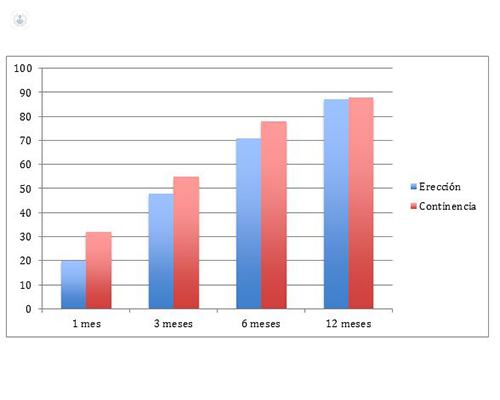How has robotic surgery changed the field of urology?
Written by:Today in the United States the vast majority of urological oncology surgeries are performed with the robot. This is because it allows the urologist to increase the precision and, therefore, the quality of the laparoscopic surgery (surgery with instruments that enter the abdomen by small holes). All this allows us to achieve lower stays, lower transfusion rates, faster recovery and better preservation of erectile function in the case of radical prostatectomy.
In the Hospital San Rafael we have results with this technique totally comparable to the results published by the best centers worldwide. In fact, it is the technique where we believe that the advantages of surgery assisted by the daVinci robot are better appreciated.
We present a 12-month continence rate of 88%, an erection rate of 87%, and a positive surgical margin rate of 9%. This allows us to position ourselves as a center of excellence at the international level.
Since January 2012, when we performed the first intervention assisted by the robot daVinci, we intervened to more than 120 patients with excellent results.
And this has occurred so universally that it is now rare that a large hospital does not have a surgical robot; In our country there are already more than 30. The field in which it is most used is Urology. Advantages and Disadvantages of Robotic Surgery
Advantages of robotic surgery:
- Greater accuracy for the instrumental movement and for the quality of three-dimensional and panoramic vision (as if we were "inside the patient")
- Cancellation of the physiological tremor with scaling of the movement (movement of 5 cms. In the hand can be 1 cm. At the tip of the instrument).
- We can operate more comfortable sittings with less fatigue, which makes it easier to perform more complex surgeries.
Disadvantages of Robotic Surgery:
- Loss of tactile sensation, supplemented by visual learning
- As in almost all technological advances in health: the cost.
Does technological progress imply the disappearance of the human factor?
Absolutely. The da Vinci robotic system is based on a "master-slave" system, that is, the device does not make any movement that the surgeon does not command, transmitting in real time; Therefore, it does not imply automatism and does not replace the human being in surgery; It does not even diminish the staff attached to that operating room.
Robotic surgery, what will be the next step?
Without a doubt, the implementation of this robot with improvements in the vision and instrumental system; Is already in its last stages the only port in which very complex surgeries can be performed through a single hole. In addition, three new robotic surgical systems in the world are already under development (some already under controlled clinical practice), which will allow improvements and reductions to facilitate the dissemination of these surgical advantages to as many people as possible.



